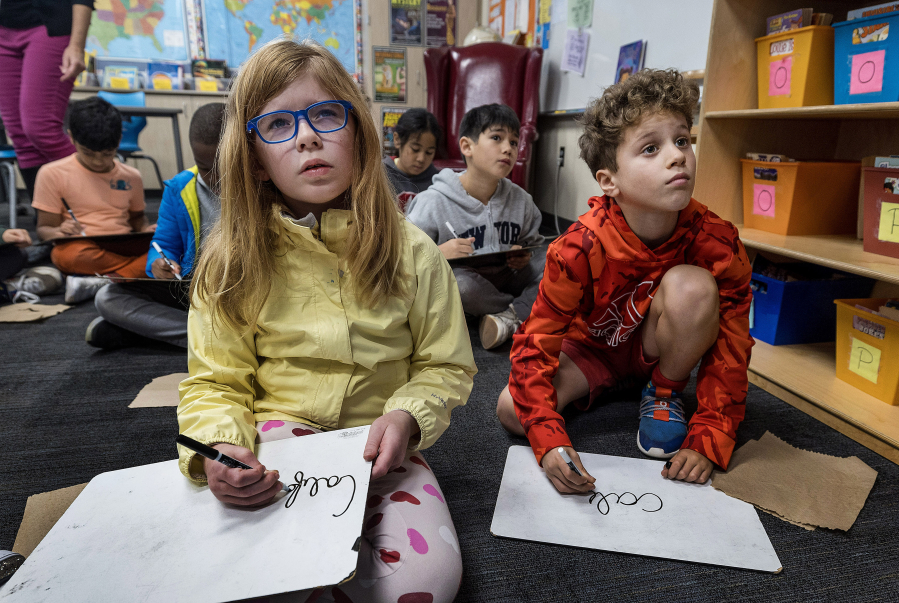SAN JOSE, Calif. — Sierra Rivera and her older sister, Dahlia, were thrilled at the idea of baking up a batch of their grandmother’s pumpkin cookies last month for Thanksgiving, but when their dad gave them the handwritten recipe, they froze.
Letters of each word gracefully flowed from one to the next in a style familiar to those of a certain age. But to the Rivera sisters, it might as well have been Latin.
“I didn’t know how to read it,” said Sierra, 8, a third-grader at Dublin Elementary School. “I thought it was like a different language.”
The girls’ father, Steve Wynn, translated Grandma’s cursive handwriting into more familiar block letters for them, and before long they all had bellies full of the warm, tasty treats. But it was stories like theirs that led lawmakers this year to conclude that learning cursive still has value — even in the iPhone age.
Gov. Gavin Newsom this fall signed a bill, AB 446, by Assemblywoman Sharon Quirk-Silva, a Fullerton Democrat and former schoolteacher, requiring cursive instruction in elementary grades starting this year.
Cursive began fading from classrooms after California and 40 other states adopted the 2010 Common Core State Standards for English and math, which didn’t include the out-of-fashion script. But the American Handwriting Analysis Foundation said several states have been adding it back, with more than 26 requiring some cursive instruction.
California kept cursive in its state standards for third and fourth grades, but it wasn’t enforced, Quirk-Silva said, leaving it up to the discretion of districts and often individual teachers. Quirk-Silva told lawmakers based on her own surveying of districts around the state that about half of California’s students are now taught cursive.
“Why in this age of technology should we even be talking about cursive?” Quirk-Silva asked Assembly members as she pitched her bill. “As a teacher for 30 years, there’s a lot of research that shows that cursive handwriting enhances a child’s brain development, including memorization, and improves fine motor skills.”
Many historical documents, famous diaries and letters and family histories are penned in cursive, Quirk-Silva said.
“Many of our private schools teach cursive writing,” Quirk-Silva said. “I want the balance, that all of our students can access historical information.”
Around the Bay Area, some districts said they’re still teaching cursive, including Palo Alto Unified and Menlo Park City School District, both upscale districts in the heart of Silicon Valley.
“Cursive is a highlight for many third graders,” said Dana Russell, a third grade teacher at Menlo Park City School District. “It’s amazing to see how seriously they take learning cursive and fun to feel their excitement.”
For one assignment, she asked them to write in cursive what they like about it, and got responses like, “Because it looks fancy and better than printing.”
But many other schools said they no longer teacher cursive consistently districtwide, including San Jose Unified, Santa Clara Unified, Milpitas Unified, Oakland Unified, Hayward Unified, San Ramon Valley Unified, Dublin Unified and Sunnyvale School District.
AB 446 wasn’t Quirk-Silva’s first attempt to enforce a cursive requirement, an idea she said she was encouraged to pursue by former Gov. Jerry Brown. But a similar bill she carried died in committee in 2018.
This time around, AB 446 met with little resistance.
That doesn’t necessarily mean everyone’s thrilled. Some school officials noted privately that it’s unusual for such a mandate to take effect in the middle of the school year, and that there’s been no guidance from the state Department of Education, leaving districts little time and no roadmap to comply.
Laura Gan, a Dublin Unified substitute, said she’s observed students losing fine motor skills, and teaches cursive to help develop them. When she made cursive part of her instruction in an eighth grade class, one parent complained, noting it’s not part of that grade’s curriculum.
Gan said that for many younger teachers, adding cursive to the curriculum might be more challenging, as they may not have taught it before or even learned it themselves.
“I think there’s a generation of teachers that themselves were not taught cursive,” Gan said.
But she and others said adding cursive to the curriculum won’t necessarily come at the expense of teaching other important skills.
“Teachers are successfully wrapping cursive into the curriculum,” Gan said, “and it’s not taking away instruction.”
Carlee Brazil, a fourth- grader at Frederiksen Elementary School in Dublin, said she’s glad her teacher taught her to write cursive, which she said helped make her handwriting larger and more legible.
“I love it,” said Carlee, 9. “Now I can write my name in cursive with my eyes shut, I call it my signature. It also helped me to write quicker and it improved my writing.”
The new law, which takes effect in January and adds cursive to the definition of handwriting in the course of study for grades one through six, means Sierra will now be taught the skill in coming years. But her 13-year-old big sister may have to learn it on her own — there’s no provision for schools to add cursive instruction for older kids who missed out.
Wynn said his older daughter Dahlia found it would be a useful skill when she recently was asked to sign a student contract to participate in a drama program and realized she hadn’t developed a signature.
“She felt left out,” Wynn recalled. “That prompted her to think, I want to learn this.”



